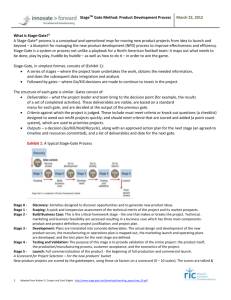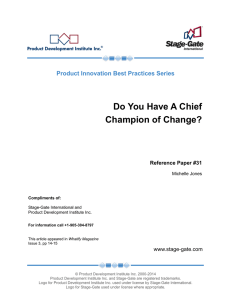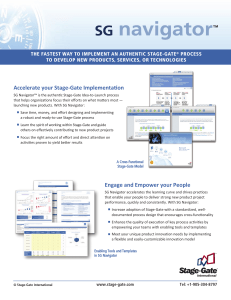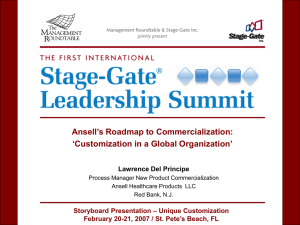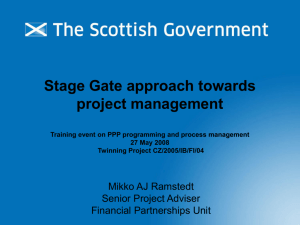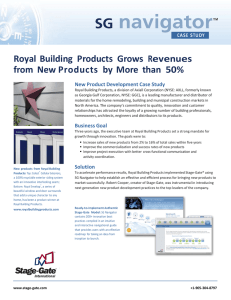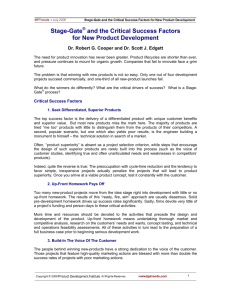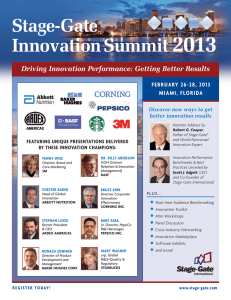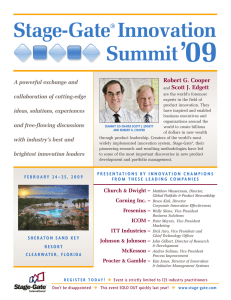Document 12650704
advertisement
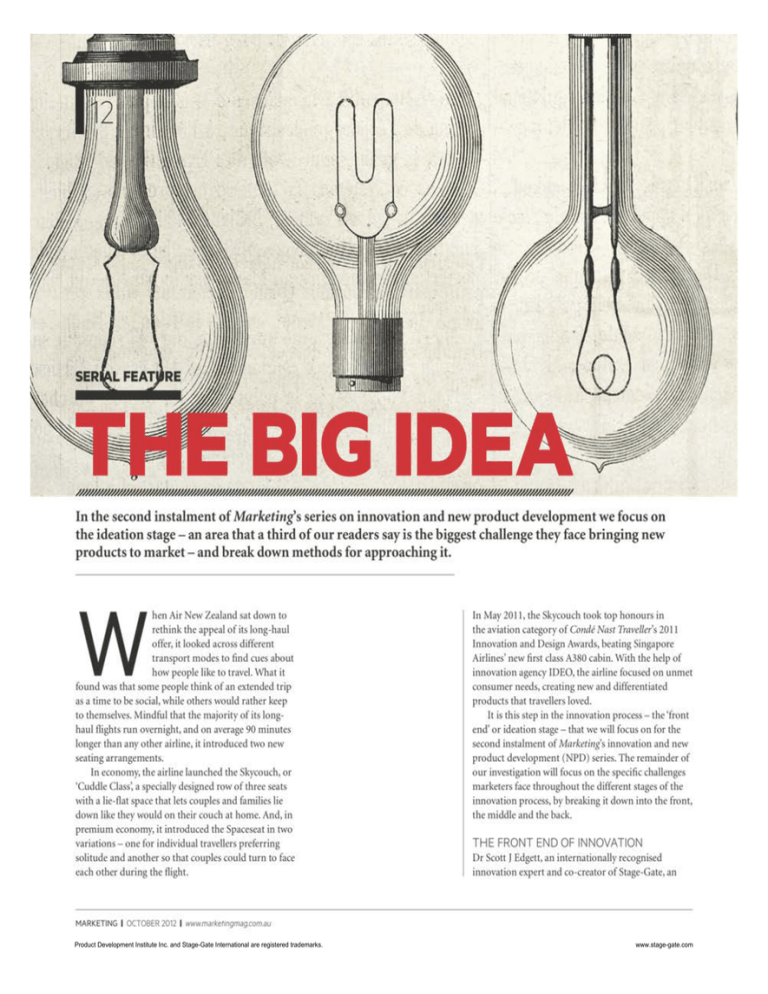
///////////////////////////////////////////////////////////////////////////////////////////////////////////////////////////////////////////////////////////
In the second instalment of Marketit~g's series on innovation and new product development we focus on
the ideation stage- an area that a third of our readers say is the biggest challenge they face bringing new
products to market - and break down methods for approaching it.
hen Air New Zealand sat down to
rethink the appeal of its long-haul
offer, it looked across different
transport modes to find cut-s about
how people like to travel. \tVhat it
found was that some people think of an extended trip
as a time to be social, while others would nuhcr keep
to themseh·es. Mindful that the majority of its long·
haul flights run ov<.·rnight, and on average 90 minutes
longer tha1'1 any other airline, it introduced two new
seating arrangements.
In economy, the airline lat1nchcd the Sk1·couch. or
'Cuddle Class; a specially designed row of three seats
with a lie-flat space that lets couples and fumiJks lie
down like they would or1 their couch at home. And, ill
premium economy, it introduced the Spaceseat in two
variations- one for individual travellers preferring
soH tude and another so that couples could turn to face
each o ther during the flight.
In May 201 1, the Skycouch took top honours in
the aviation ca1cgory of Co,de Nast Traveller's 20 II
Innovation and Design Awards, beating Singapore
Airlines' new first class A380 c~bin. W ith the help of
illllOvatiO•'I agency IDEO. the airline focused on unmet
consumer needs, creating new and differentiated
products that travellers lo,,ed.
h is this step in the innovation process - the 'front
end' or ideation s tage- that we will focus on for the
second ii'IStaJment of Marketin(s innovation and new
product development (NPD) series. The remainder of
our investigat ion will fOC\IS on the spedfic chaUengcs
marketers face throughout the d ifferent stages of the
innovation process. by breaking it down into the front,
the middle and the back.
THE FRONT END OF INNOVATION
Dr Scott J Edgett, a n internationaUy recognised
innovation t·xpcrt and co-creator of Stage-Gate, an
MARKETING I OCTOBER 2012 I wMV.marktr•ngmag.com.au
Product Development Institute Inc. and Stage-Gate International are registered trademarks.
www.stage-gate.com
innovation framework used by many oft he world's
biggest brands. says the front end, or the idea stage,
is where the highest risk lies. But it's also the stage
most comsnonly shor1cut. "'It's interesting that the
area with the highest risk is also the cheapest pa rt
of the proce;s," says Edgell, highlighting companies'
willingness to skimp on investment in the front end,
often to their detriment.
Big companies ha\·e becosne skilled at the middle
and back end of the innovation process- the product
building and commercialisation stages. accord ing to
Edgell. But they do not excel lo the same degree at
ideas. " It is at the front end where we see the real change
and challenges ... compal''lies are s.·wing '\Ve haven't
got enough good ideas coming i n~·· \Vith such intense
competition and the maturation o f many categories,
good ideas are becorning harder to come by. Yet without
them successful innoV3tion cannot occur- no amount
of testing or refining can 1nake a bad idea good.
The fro nt end is where the inspiration for the
J'I Cw product is fo\md, and assessed for its viabilily. Jt
includes tasks such as b rainstorming and discovery,
market analysis, matching to corporate capabilities
and preliminary financial and business assessment.
It poses a number of challeng<.>s, from understanding
COJ'I SUJrter in sights and finding great ideas co acc,arace
and early project selection.
Failure to understand and adequately respo nd
to unmet consumer needs, or inadequate market
anaJysis, was nominated as the number one cause of
new product failure b)' several of Marketing's sources.
Because identifying and qualifying genuine growth
oppo rtunities is challenging. many compan ies leap
from high-level ideas to concept development. lt's not
that they ignore category assessm<.·nt overa.ll, but the
urge to ' ialJlOvate• often leads to a con"lpacted process
that s kips necessary steps. \\'hen the fron t end is left
incomplete, the bridge between consumer need and
prod uct often fails to meet.
Innovation that invests significa nt time and
resources into the from end is ine\'itably more
~
§
~
§
§~
~
§
§~
§
~
§
~
§
~
§
§
~
NPD SERIES ROADMAP
September: Necessity is the mother of innovation
October: The big idea
November: Buildmg the product
December/January. Commeroalisat1on
No matter
what's
launched at
the back end,
if it came from
a bad idea, it's
not going to
sell. If it's J·unk
in, it's jun k out.
successful than that which doesn't.lf steps are to be
skipped, ensure the rigour of the process matches the
complexity of the innovation being conductt-d, Edgett
advises. "If it's a h igh risk, highly complex project, do
it through the typical five-stage IStage-Gate I process,
but if it's just a tweak o r an innovation, yota need co go
fast to market. Have you streamlined your process to
match that?.,
A SLAVE TO THE CUSTOMER
"A slave-like dedication to the voice of the customer"
is an integral part of the new product development
process, according to Stage-Gate's research. Innovation
that has a strong consumer focus enjoys more than
double the success rate of innovation that doesn't.
Despite this, a strong market orientation and customer
focus is absent from many businesses' NPD projects.
Idea generation based on consumer insights or
input is a constant presence in Arnott's innovation
pipeline. RegionaJ marketing director at the s nack
food manufacturer, S\asan Massasso,says market
interrogation is a daily reality for her team something they live and breathe. •<we have extensive
brand plam'l ing and processes that interrogate the
broader marketplace opportunities and where we want
to take our brands ... we are stepping in and reviewing
with consumers, with shoppers, with customers when
we bring things tO market.
"But we're also really dear tha t consumers aren't
necessarily going to give you alJ the answers either,~·
Massasso adds ... \Ve work very dose])• with our insight
partners to also read between the lines and develop
things that we have built upon in pre\•ious years.
"The power is in how we, as people that
thoroughly understa nd our bran ds and the categories
and the marketplaces, apply 1 his insight i11 order to
bring the innovation to market and be ahead of the
game. rather th;,m just ret rospectively in the game."
JUNK IN, JUNK OUT
" How much would 1 spend to get one idea chat J could
actually launch where I can make $300 or S400 million
a year in revenue?" a marketing exect1tive asked Edgett
rhetorically. T he impl ied answer: a lot of money.
The critical task of unearthing an idea that has k-gs
is becoming a n increasingly difficult feat. No matter
what's launched at the back end. if it came from a bad
idea, it's not going to sell If it's junk in, it's junk out.
Innovators spend millions of dollars on insights
a nd identifying <white space•- opportunities made
wwNftUitktMgfnc)9.COI'I'\8u
Product Development Institute Inc. and Stage-Gate International are registered trademarks.
I OCTOBER I MARKETING
www.stage-gate.com
up of needs or demands. which can often be latent,
not currently fi11ed. Research organisations and
consuhancic-s have tried and teSt(.'d techniques for
finding white space. which package together a range of
ideation approaches.
STAGE-GATE
AN IDEA·TO·LAUNCH INNOVATION FRAMEWORK
USED BY MOST OF THE WORLD'S BIGGEST
COMPANIES
Nielsen has 'Market Brand Adviser', which
detennine-s the drivers of categories and seeks to
understand how c;.teh brand is performing ag<tinst
those drivers. It screens ideas through to concept
refinement using qualitative and quantitative
approaches. Andrew McQuilJan. vice president of
innovation for Nielsen, Pacific, explains. "Concept
development is often assisted by qualitative work to.
ill some cases, come up with concepts from ideas, and
in other cases to refine concepts. \.Ve've incorporated
factors of successful products into our qual interviews,
so that we're asking questions that improve the odds
of success once we start doing the quantitative work.•'
TNS has 'Matrix•, an approach that identifies,
sizes and prioritises growth opportunities based on
co•uurner needs. Ray Crook. regional direc tor of
innovation and product development, Asia Pacific.,
at the research firm, s.~ys there arc five 'drilJ sites'
investigated for new ideas: the normal'friction life
tensions' that people have, core category needs. usage
cx:casiOJl needs. COJlvergence a11d breakthrough
innovation opportunities. The focus is turning back
to bre-.tkthrough innovation as confidence improves.
Crook notes, but it is hard to deliver on. "It's bringing
the polar needs that consumers have together. A classic
one would be heahh versus t·a ste within snacki11g ...
Edgett says the techniques companies are using
to help g.ener.1te ideas and turn consumer insights
into something tangible to the product development
team are changing rapidly. " It's tough to constantly
come up with a new idea, the techniques they•re ll)'ing
are different, and they're trying all sorts of different
techniques in the hope some of them will work."
The 'stages' are where the PfOiecf team undertakes key
tasks ro advance ro the nexr dec1s10n po1nt. or gate.
They"re cross·functional- there are no R&D or marketing
stages. but a set of parallel activities undertaken by
people from different funcrional areas in the firm. working
together to complete each stage. The 'gates' preceding
each stage are 'go/k1ll dec1sion p01nts". Gates serve as
quality·control checkpoints. tunnelling out sub-standard
ideas and projects.
FRONT END: THE IDEA (THIS ISSUE)
8ta1nstotmu>g and d.s<:Ov<!ty
§~
~
~
~
§
~
§
§§
~
~
§
~
~
§
~
~
§
~
IDEA DETECTORS: WHICH TECHNIQUES
WORK BEST?
In 2010, Stage-Gate concluded analysis on a study of
ideation techniques used by 160 US firms, sparked b)'
earlier findings that only 19 percent of busines.'ies had
proficient ideation processes. EightC'Cn different sources
of new product ideas were investigated. including eight
'voice·of·customer' techniques. six open innovation
approaches, and a handfuJ of other internal and
strategic approaches. The study found ' ·oice of
customer methods delivered the best ideas. whiJc open
GATE" 1: Does the Idea merit any WOtk?
Failure to
understand
and adequately
respond to unmet
consumer needs,
or inadequate
market analysis,
was nominated
as the number
one cause of new
product failure by
Marketing's sources.
STAGE 1. SCOPING: a quick investigation and sculpring of
the project
GATE" 2: Does the idea JUStify extensive investigation?
STAGE 2. BUILD THE BUSINESS CASE: the deta1led
homework leading to a defined product, a business
justrfication and a detailed plan of action for the next
srages.
GATE 3: Is the business case sound?
MIDDLE: BUILDING THE PRODUCT (NOVEMBER
ISSUE>
STAGE 3. DEVELOPMENT: the actual design and
development of the new product. Add1110nally, the
manufacturing (or operations) process is mapped out, the
marketing launch and operahng plans are developed. and
rhe test plans for rhe nexr srage are defined.
GATE" 4: Should the project be moved to external testing?
STAGE 4. TESTING AND VALIDATION: the vetificat10n of
the proposed new product, its marketing and production.
GATE" 5: Is the product ready for commercial ~unch?
BACK END: COMMERCIAUSATION (DEC/JAN ISSUE>
STAGE 5. LAUNCH: full commercialisation of the product
- rhe begtnnmg of full production and commercial launch
and selling.
MARKETING I OCTOBER 2012 I www.market~ngmag.com.au
Product Development Institute Inc. and Stage-Gate International are registered trademarks.
www.stage-gate.com
CASE STUDY:
VIVA SHOWER FAST
WIPES
The cleaning ca1cgory" a h1gh frusuahon calcgO<y and
one where hrrle tnnovahon has taken place in the past f1ve
to 10 years. accord1n9 ro Usa McKee. market1ng manager
fO< VIVA towel and cleanong producls. K1mberly·Ciarl:.
The paper P<oducr manufacrurer brought a 'blue
sky' s~r dean1ng Pfoducr to market. adapflng supply
dla•ns and manufacrunng processes ro incorporate
dean.ng product capa~1hes 1n O((Se-r to meet consumer
de5ore fO< a "mplofoed deanong P<OCess.
THE IDEA
!'riOf lo I he launch ol VIVA Shower FasT Wipes. over 140
SKUS conlflbuled 10 The household deanong market w11h
balhroom clean1ng represen11ng 12 percen1 of lhos group
Wllh the segment decl1n1ng at approxmlately four
percenl each year. Kimberly-Clark 1den11fled a clear need
to revitalise the segment to not only offer consumers a
better and cleverer ahernat1ve to clean thetr showers.
but also to dnve value and n\Cremenral volume'" the
~
ethnography
~ 1s time
~~ consum1ng
§
~ and expensive
§~ to undertake,
§~ and if
§
§
§ observation or
§
§
§
r terpretat1on
§
§
§
§
§ s -Ills are
§
§
§ lack1ng, 1ts
§
§
§ accuracy
§~
§
§ can be
§
§
~ compromised.
category
Consumer research uncovered lhar The task of
cleanong the sho- screen os one of the mosr dreaded
household chO<es Tlvee on 6ve consumers believed 1hey
dodrfl have a sa"'fac1ory soltmon fO< soap scum on The
shower screen and toles. They deSired deaiWlQ PfodUCIS
thaT are easy to use and lhaT alow Them to fit cleanong
onlo theor busy loves Many found the SPfays. cloThs.
scrubbong brushes and need to change clothes pull hem
off clean1ng I he sh~ and a source of frusTratoon Trends
also showed consumers prefer not to use htghly toxtc.
strong smelling chemtcals ro deal\ and seek conven•enr
solulions 1ha1 deliver effoc:acy Wllh ease.
The VIVA Shower FaSI Wopes concep1 was developed
to meet consumers· needs by prov•d•ng a s•mple. QUICk
and effec-hve soturtOn ro shower deamng frustrations
The bus1ness case for lhe tdea was sTrong- !here
was no cannobalosa11on potentoal as KJmber1y.Ciark had
no exostong PfodUCIS on lhe ballvOO<n clearong category.
meaiWlQ al volume v.ould be oncrernenTal Brand
equoTy on the vrvA name emerged as a competdM!
a<tvanlage
Nexr monrll The JO<Irney Komberly.Ciark embarked
on ro resr. rer.ne and df!Velop rrs breakrtrrough deanong
producr
innovation yidd<d disappointing results and th< rang<
of other techniques were suited to niche situations
only. lt also rcv~alcd that while some methods were
used extensively, notably focus groups and siUdies
of early ado)'tcrs. others such as ethnography or
co·creation communities were less popular despite
proving to be more fru itful sources of ideas.
ETHNOGRAPHY
Ethnography was found to provide the dc.:pest
insights into user~· unmet and unarticulated nteds
and is a powerful source of breakthrough ideas, the
study found. The approach in,-olvcs 'camping out'
wtth consumers m their natural ~tring for extend«i
periods of urn<, watching and probing as they go
about their .-·rr)-day li,.es, Th< depth of knowl«lg<
that can be goin<d is unrivall<d by other techniques.
It is, howt\'Cr, time consuming and expcnsiYt
10 undertake. and also subject to the skill of I he
researcher or observ<.'r. If observation or intcrprct,Hion
skills a rc lacking, its accuracy can be compromised.
A scolt-d·down version of e thnography - customer
visil tcoms, where cross·functionaJ teams interview
customers - ~1bo emerged from the study as an
undcr•ppreci,ued approach.
FOCUS GROUPS
Th< stalwart of qualitati,·e re><arch, focus groups are
still widely_.. and a fruitful source of ideas. They
often in\'oh·e proj«tion techniqua to draw out the
trur dri\·~rs behtnd "-ants and ne«<s. ln,·ef'S(' br.un·
storming-·staning with product shortcomings. then
brah\storming to propose solutions- is also a tri~
and tested methodology for ideation.
' LEAD USER' ANALYSIS
Analy~is of'lcad us.ct•s', or early adopters that have
been identified fo r their 'future shaping' proclivities,
can yield illllOVlHivc product ideas. It was an effective
and popular lechniquc among the firms stud ied. credited for uncovering ideas for people who are'ahead
of the "-ave:: The major chalJenge with its use is in
id<ntifying le.d usen, gelling th<m to participat< and
stroctunng the research.
COMMUNITIES/CO<REATION/
CROWDSOURCING
Onlu'\t communities, virtual focus groups and
crowd.sourcing approaches have become widely u~ed
techniques. Qualitative research conducted online
www m.wkt ltnOmagcom.tu IOCTOBER 2012 I MARKETING
Product Development Institute Inc. and Stage-Gate International are registered trademarks.
www.stage-gate.com
has a number of benefits. inclt1ding cost and logistic:aJ
efficiencies, the ability to use multimedia content as
stimulus and a d igitaJ research environment where
panicipams are usually n'lo re candid. Its useful
application depends on the aims of the project and the
participants reCrtlitcd to take part. The panel recruited
to take part can be made up of lead users, po pulation
reprcscnta th'C groups or brand/category enthusiasts.
Researching enthusiasts can be a double-edged
sword. \Vhile leveraging their passion for the brand or
category can deliver great results, their engagement
with the topic can lead to biased results.
Crook advises being targeted with co-cr<.·a tion and
clearly defi1ling to participants where the opportunity
fits. "Co-creation is a good way to get ideas from
consumers, butt hey need to be harvested in the right
way. You need to ensure that you're co-creating around
are;.ls where there is a space. \Vc might get there and
say, 'Let's go out and co-create a light tasting beer:
But we need to understand if there is a gap in the
marketplace fi rst."
Generally, the effectiveness of community
approaches was rated highly in Stage-Gate's
research. T hey can be set up to be ongoing, similar
to traditional customer advisory boards. but the ir
ru11nir1g costs are low. A key challenge is, while
this method comes with its efficiencies, it requires
considerable skill, insight and time to analyse what is
often a la rge amount of written responses.
~
~
§~
§
~
§
§
~
§
§
~
§
~
§
~
~
§~
~
§
~
§
~
§~
§
~
§
~
OPEN INNOVATION
Open innovation opens the doors of the o rganisation
to idC"dS,technology. intellectual propert)' and even
fully·developed products to outs ide sources. Jn spite
of the hype about this a pproach, open methods aren't
proving particularly popular, according to Stage-Gate,
nor are they perceived to be particularly effecti\•e
as SOtlrces of new product ideas. Out or six open
innovation approaches investigated, the three most
eff<.-ctivc were ideas from partners and vcndo~. ideas
from the external scientific community and ideas
from start-up businesses. None, however, proved to
be as effective as voice-of-customer methods, possibly
due to their newness. T hey have potential, however,
by virlue of their access to a wide a rray of parties- a
'brains trust' of experts beyond the ability of the
standard organisation to employ.
The open approach is one that IDEO has thrown
itself into, according to its chief creative officer,
PauJ Bennett. The agenC)' was contracted by the
Formally
soliciting new
product ideas
from your own
emp Ioyees
was the most
popular
ideation
method in the
survey, but its
effectiveness
was found
to be
disappointing.
Queensland Government in 201 1 to find solutions
to the gap between rural food production and urban
food consumption. An open challenge was posed at
last year•s Ideas Festival to create a closer connection
between locaJ food production and consumption and
improve sustainability. Concepts were then gathered
together to input into the developrnent of solutions to
the challenges.
A major disadvantage of the approach is the sheer
amount of time and work it takes to scan, solicit,
handle and process the ideas or intelleChlal property.
"It takes an a rmy of people;• o ne of Stage· Gate's
respondents indicated.
OTHER METHODS
Top-down o r strategic approaches to innovation
have proven fairly popular over the years and include
two methods: exploiting disruptive technologies and
•peripheral vision'. Both emerged in the research as
widely used and effective idea generation techniques.
Patent mapping and mi11ing is also well-known
a nd quite popular for identifyi ng areas of competitor
activity and hence potential areas of focus. Man)' firms
engage in this activity to stay across what competitors
a re doing, but the approach is a reactive, rather than
proactive, ge1'1erator of new ideas.
'Internal idea capture' - formally soliciting new
product ideas from your own employees- was the
most popular ideation method in the survey, but its
effectiveness was fo und to be disappointing.
The fron t end of the ilH'IovatiOll process is
the most important s tep in the journey; it's the
founda Oon upon which the project is buih. Executing
the first stage of developing a new product is a matter
of fo rmalising the st-arch fo r a big idea, while doing
b ackground homework to assess its \•iabilily and
listening to the voice of the consumer every step of
the way. Nearly all of the best performers h'we a game
plan and use a structured approach, such as Stage·
Gate. Innovation is in tcgratt..-d into the culture of their
o rganisations, aligned to their corporate strategy and
effective portfolio management ensures the right mix
of innovation projects is p1..1t together.
'With incrementa l innovation reaching near
exhaustion, the hunt for bigger and bctt<.·r ideas is a
top priority. T.'lking a big idea and making it a reality
- like Air New Zealand d id by making it possible
fo r passengers to lie down in economy- requires
a s trong focus o n, and respect for, the front end of
innovation. M
MARKETING I OCTOBER 2012 I www.marker.ngmag.com.au
Product Development Institute Inc. and Stage-Gate International are registered trademarks.
www.stage-gate.com
Stage-Gate International is the world's leading full-service provider of solutions which enable
organizations to improve their Product Innovation and Portfolio Management capabilities and
performance. Our clients include 5000+ organizations of all sizes across all industries.
+1-905-304-8797
www.stage-gate.com
Visit our website and subscribe to receive the latest research, information and
complimentary articles to keep you current in product innovation!
